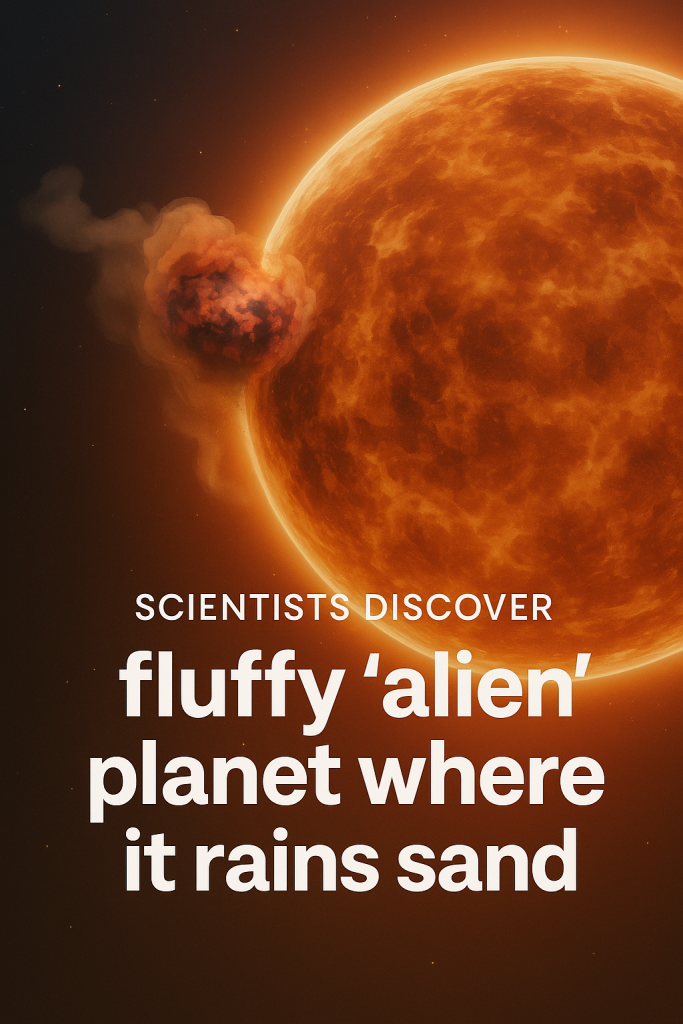In a groundbreaking discovery that reads like science fiction, astronomers have identified a unique “fluffy” exoplanet where an astonishing meteorological phenomenon occurs: it rains sand. This alien world, unlike anything in our solar system, challenges current understandings of planetary formation and atmospheric science, offering an extraordinary glimpse into the diversity of planets in the cosmos.
The newly discovered planet, orbiting a distant star several hundred light-years away, exhibits an unusually low density and a puffy, inflated atmosphere, earning it the nickname “fluffy planet.” Unlike rocky planets such as Earth or Venus, or gas giants like Jupiter, this exoplanet’s atmosphere is so thick yet tenuous that it appears to have an extraordinarily light composition. This unusual trait is central to the remarkable weather conditions scientists have identified.
Sand Rain: A Phenomenon Beyond Earthly Imagination
Using advanced spectroscopy and infrared imaging provided by space-based telescopes equipped with the latest instruments, researchers detected signatures of silicate particles condensing in the planet’s upper atmosphere. This led to the astonishing conclusion that instead of water or methane rain, this world experiences precipitation made up of tiny grains of sand—microscopic mineral particles suspended in swirling clouds—and that these grains fall as sand rain.
This feature was observed through the planet’s unusual light spectrum: high-altitude clouds composed primarily of silicate dust are blown by fierce winds, and the atmospheric chemistry creates conditions allowing particles to condense and precipitate. This sand rain phenomenon is believed to coat the planet’s surface and contribute to a cycle of atmospheric dust regeneration.
What Makes This Planet ‘Fluffy’?
The planet’s surprising fluffiness is due to its very low density, which researchers attribute to a combination of a large radius and a relatively small mass. This suggests a thick atmosphere made of light gases enveloping a smaller, possibly rocky or icy core. Such characteristics set it apart from classical gas giants and ultra-dense rocky planets, placing it in a novel category of exoplanets. The inflated gas envelope might be caused by intense stellar radiation heating the upper layers, causing the atmosphere to expand dramatically.
“This planet is unlike anything previously observed,” said an astrophysicist involved in the study. “Its extremely low density combined with unique atmospheric chemistry creates conditions where mineral particles can condense and fall as grains of sand, a phenomenon unheard of in our solar system.”
Implications for Exoplanetary Science
Discovering an exoplanet with such exotic weather dramatically expands the range of known planetary environments. It challenges models of atmospheric dynamics and chemical cycles, providing fresh data on how planets evolve, especially those close to their stars that experience intense radiation and heat. It also drives home the diversity of worlds beyond our solar system—some so alien that they defy easy categorization.
Scientists hope that further observations of this planet and others like it will improve the understanding of condensable species in exotic atmospheres and the complex interactions between atmospheric particles and stellar radiation. The discovery underscores the rapid advancement of observational technology and analytical techniques that make such revelations possible, even at extreme distances.
The Road Ahead
As telescopes become more powerful and space missions more ambitious, astronomers plan to conduct follow-up studies focusing on the chemical makeup of the sand particles and the planet’s overall atmospheric dynamics. These efforts aim to provide more detailed insights into its geology and climate, which may reveal even more surprising characteristics.
This sand-raining fluffy exoplanet not only fuels imagination but also inspires new avenues of



